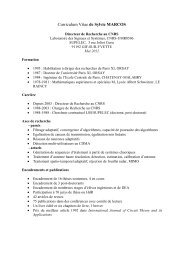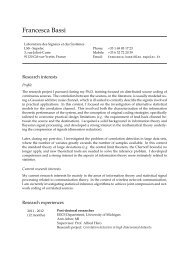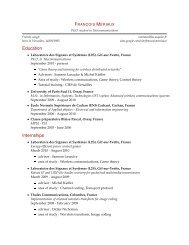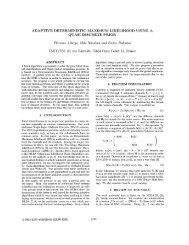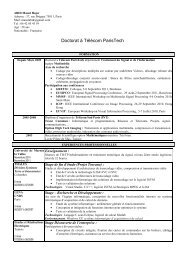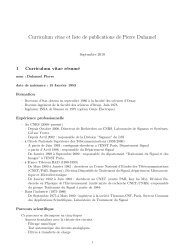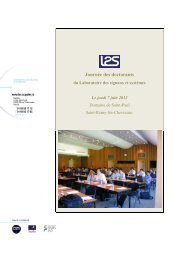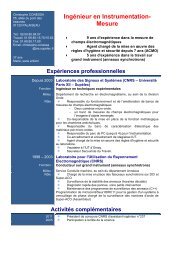THÈSE DE DOCTORAT Ecole Doctorale « Sciences et ...
THÈSE DE DOCTORAT Ecole Doctorale « Sciences et ...
THÈSE DE DOCTORAT Ecole Doctorale « Sciences et ...
You also want an ePaper? Increase the reach of your titles
YUMPU automatically turns print PDFs into web optimized ePapers that Google loves.
xii<br />
Table des matières<br />
2.4.2 Méthode de redesign . . . . . . . . . . . . . . . . . . . . . . . . . . . . 40<br />
2.4.3 Commentaires . . . . . . . . . . . . . . . . . . . . . . . . . . . . . . . 41<br />
2.5 Exemple numérique . . . . . . . . . . . . . . . . . . . . . . . . . . . . . . . . 42<br />
2.5.1 Commande adaptative continue . . . . . . . . . . . . . . . . . . . . . . 42<br />
2.5.2 Commande échantillonnée . . . . . . . . . . . . . . . . . . . . . . . . . 42<br />
2.5.3 Simulations . . . . . . . . . . . . . . . . . . . . . . . . . . . . . . . . . 43<br />
2.6 Conclusion . . . . . . . . . . . . . . . . . . . . . . . . . . . . . . . . . . . . . 46<br />
3 Backstepping robuste échantillonné 47<br />
3.1 Introduction . . . . . . . . . . . . . . . . . . . . . . . . . . . . . . . . . . . . . 47<br />
3.2 Stabilité entrée-état des systèmes à données échantillonnées . . . . . . . . . . 49<br />
3.3 Problématique . . . . . . . . . . . . . . . . . . . . . . . . . . . . . . . . . . . 51<br />
3.4 Stabilisation entrée-état semiglobale pratique . . . . . . . . . . . . . . . . . . 52<br />
3.5 Stabilisation semiglobale pratique asymptotique . . . . . . . . . . . . . . . . . 56<br />
3.6 Discussions . . . . . . . . . . . . . . . . . . . . . . . . . . . . . . . . . . . . . 61<br />
3.6.1 Application aux systèmes de la forme (3.1) . . . . . . . . . . . . . . . 61<br />
3.6.2 Cas des approximations d’ordre supérieur . . . . . . . . . . . . . . . . 61<br />
3.7 Exemple numérique . . . . . . . . . . . . . . . . . . . . . . . . . . . . . . . . 62<br />
3.8 Conclusion . . . . . . . . . . . . . . . . . . . . . . . . . . . . . . . . . . . . . 62<br />
II Observateurs pour les systèmes en réseau 67<br />
4 Introduction 69<br />
4.1 Systèmes commandés par réseau . . . . . . . . . . . . . . . . . . . . . . . . . 69<br />
4.2 Commande des NCS . . . . . . . . . . . . . . . . . . . . . . . . . . . . . . . . 73<br />
4.2.1 Émulation . . . . . . . . . . . . . . . . . . . . . . . . . . . . . . . . . . 74<br />
4.2.2 Co-synthèse du contrôleur <strong>et</strong> du protocole . . . . . . . . . . . . . . . . 77<br />
4.3 Synthèse d’observateurs pour les NCS . . . . . . . . . . . . . . . . . . . . . . 78<br />
4.3.1 Problématique <strong>et</strong> état de l’art . . . . . . . . . . . . . . . . . . . . . . . 78<br />
4.3.2 Cadre d’étude . . . . . . . . . . . . . . . . . . . . . . . . . . . . . . . . 79<br />
4.3.3 Travaux de thèse . . . . . . . . . . . . . . . . . . . . . . . . . . . . . . 88<br />
5 Conditions suffisantes pour l’émulation d’observateurs pour les NCS 91<br />
5.1 Introduction . . . . . . . . . . . . . . . . . . . . . . . . . . . . . . . . . . . . . 91<br />
5.2 Hypothèses <strong>et</strong> analyse de stabilité . . . . . . . . . . . . . . . . . . . . . . . . . 92<br />
5.2.1 Convergence pratique . . . . . . . . . . . . . . . . . . . . . . . . . . . 92<br />
5.2.2 Convergence asymptotique . . . . . . . . . . . . . . . . . . . . . . . . 102<br />
5.3 Applications . . . . . . . . . . . . . . . . . . . . . . . . . . . . . . . . . . . . . 103<br />
5.3.1 Observateurs linéaires . . . . . . . . . . . . . . . . . . . . . . . . . . . 103



